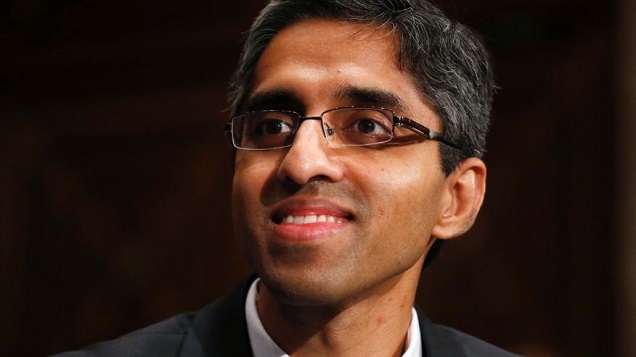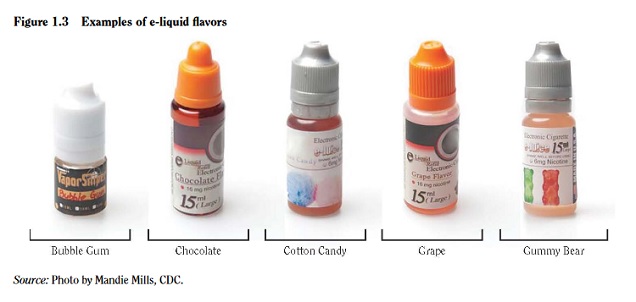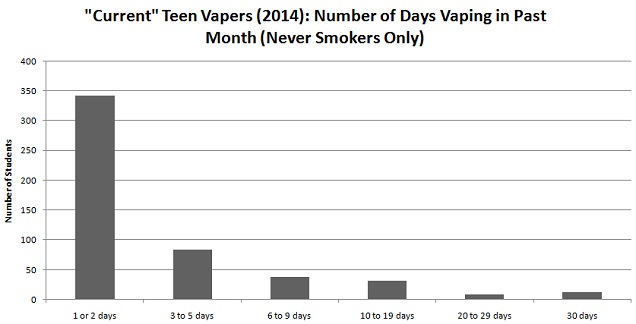
Earlier this year, the Royal College of Physicians released a report that enthusiastically recommended vaping for smokers who can’t or don’t want to stop consuming nicotine. Among other statements, it stressed that e-cigarettes are vastly safer than cigarettes, and their risks are unlikely to exceed 5 % of the risks of smoking. In other words, they broadly backed Public Health England’s 95 % safer statement, but added the crucial caveat that this is realistically the most risk that can be expected, and that it’s probably much less than that.
Yesterday, the Surgeon General released his first report on e-cigarettes, and it probably won’t come as a surprise that the tone is a lot more critical. In fact, it’s led to headlines like “Surgeon General sounds the alarm on teens and e-cigarettes” and the Surgeon General has called rising vaping among teens “a major public health concern.”
The contrast between these two reports is immediately striking. Are they even working from the same data? Well, of course they are. The evidence is the evidence. However, if you choose to be selective in your referencing of research, your reporting of the results of research and your focus in terms of topic, you can create concern where none is justified, or ignore it when it would be warranted.
For the public – who are generally confused by the continuing back-and-forth of claim and counter-claim on the topic of vaping – the contrast between the reports will only exacerbate their misunderstanding of the relative risk of vaping compared to smoking. The big question is: how do you know which report to believe?
The unavoidable fact is that at least one of these reports is biased. You can’t come to two diametrically opposed conclusions based on the same data without some bias being involved. Unfortunately for the Surgeon General, even a cursory look at both reports makes it clear that while the RCP is comprehensive, scientifically-robust and above all, rational, the Surgeon General’s bias shows right from the beginning.
Here are 9 ways the Surgeon General puts the anti-vaping narrative ahead of the facts.
1 – It Creates False Context With Discussions of Things Like Low Tar Cigarettes

An immediate red flag in the Surgeon General’s report is the discussion of things like “low tar” cigarettes and other flawed claims from the tobacco industry that certain products are less dangerous.
This might not seem much of an issue at first sight, but anybody who’s been keeping up with the debate surrounding vaping knows that this is establishing a central point of the core anti-vaping narrative. Namely, that “Big Tobacco” is telling you that vaping is safe, and they’re demonstrable liars.
However, the comparison is so invalid it’s basically a joke. Low tar cigarettes still involve burning tobacco. When you burn tobacco, tons of harmful chemicals are created, and these lead to disease when inhaled over the long term. Low tar cigarettes used little tricks like air-holes in the filter to dilute the smoke, and this makes them look a lot less harmful from the perspective of a smoking machine.
Smoking machines don’t care how much nicotine is in the smoke or what it feels like going down, they just go through the pre-programmed puff protocol and record the results. However, real smokers ended up feeling unsatisfied when the smoke was diluted by air, and puffed more deeply and smoked more to compensate. The end result was low-tar cigarettes being exactly as dangerous to the smoker as high-tar ones.
Vaping, in contrast, involves no combustion, and as a result emits vastly fewer harmful chemicals than cigarettes do. E-cigs contain no tobacco at all, just the same extracted nicotine you’ll find in nicotine patches and gums. Most importantly for the implied comparison, vaping delivers substantial amounts of nicotine while still exposing users to much, much lower amounts of any harmful chemicals.
The report doesn’t explicitly say that e-cigs are just the next “low tar” scam, but by presenting a history of failed “safer cigarettes” before introducing them, the intention is clear. The only difference between this and openly anti-vaping campaigns like the disastrous “Still Blowing Smoke” is how blatantly the message is portrayed.
2 – The Report Focuses on Youths and Ignores Adult Smokers

Public Health England (PHE) and the Royal College of Physicians (RCP) both addressed all of the key issues related to vaping in their reports. The reports covered the effectiveness of e-cigs for quitting, the risks they’re likely to pose to users, population-level effects on both adults and youth, and loads of other topics. Since e-cigarettes are new and there’s a lot of confusion, the priority for these public health organizations was addressing as many of the key outstanding questions as possible.
In contrast, the Surgeon General’s focus is considerably narrower. It solely focuses on youth vaping, and almost completely ignores the intended market of adult smokers. There’s a problem here in that the key question for most people is “are e-cigarettes safer than cigarettes?” In fact, this is the key issue in the whole debate. If they are, then switching from smoking to vaping is a positive move for any smokers, and should realistically be encouraged.
Based on this, it’s hardly surprising that that’s exactly what PHE and the RCP did. They looked through the evidence, correctly interpreted it as showing vaping being much safer than smoking and reported that as a conclusion. The (valid) concerns about non-smoking youth starting to vape were still addressed, but that wasn’t the sole focus.
So why would you make it the sole focus? Because even if e-cigarettes are vastly safer than cigarettes, if non-smoking youth start vaping – and especially if they progress to smoking – then vaping could still be a bad thing for society overall. If you were interested in painting vaping as a potential threat, focusing on youth use allows you to largely ignore the key issue of the relative risks of tobacco cigarettes and e-cigs for adult smokers. Instead you can concentrate on speculative and unsubstantiated concerns about possible gateway effects and tug on all of our heart-strings about the poor little kids being targeted by the big bad addiction-fuelled industry. The video released to accompany the report literally asks if you want to turn your child into an experiment.
I’ll stress again that these are real concerns. But there are many more relevant issues that could have been adequately addressed in the 250-page report as well as these concerns. The reason the report focuses specifically on them is because to paint vaping as bad without completely and utterly ignoring the evidence, you need to make it all about the Children™.
PHE and the RCP gave smokers, doctors, journalists, concerned members of the public and parents everything they needed by objectively looking at all the facts. The Surgeon General was more interested in bolstering anti-vaping talking points with a seemingly-authoritative report.
3 – It Shows Pictures of E-Liquid, But Includes Bubble Gum, Gummy Bear and Cotton Candy

Following on from the choice to focus on the Children™, the next standard anti-vaping talking point is to point out that some flavors sound like they would appeal to children.
The report points out that a study from 2014 estimated that there were at least 7,700 unique flavors of e-liquid. This is clearly a lot of different variations. Pretty much any flavor you can think of is available in e-liquid form, though sweet flavors are much more likely to be found than things like steak and ale pie for lasagna for fairly obvious reasons. Savory flavors are rare, overall, because they’re not as tasty and they don’t translate well to vaping. Tobacco and menthols are common, but these tend to be mainly used by smokers who recently switched from vaping.
The upshot is that desserts, sweet flavors, fruits and some beverage flavors very much dominate the vaping landscape. This includes everything from strawberry cheesecake through to mocha and peanut butter cookie. But there are a only few examples – from the thousands available – that get mentioned a lot in anti-vaping communications. Guess which ones the Surgeon General referenced?
That’s right, gummy bear, cotton candy and bubble gum. The remaining two flavors pictured are chocolate and grape, which are fine, but look a lot of worse in a line-up with the others. Yet again it seems like the report was a lot more interested in hitting on anti-vaping talking points than giving an honest representation of the range of flavors available.
They needed to craft a narrative, and a key part of that narrative is “child-appealing” flavors. It doesn’t matter that adults also like flavors or that one of the only studies to ask about specific flavors found that non-smoking teens were more interested in whisky e-juice than bubble gum.
4 – It Leaves Essential Information Out of Summaries and Chapter Conclusions

Much of the meat of the report concerns the evidence on youth vaping, particularly the National Youth Tobacco Survey (NYTS) data. The NYTS data is released each year to much panic about the “epidemic” of teen vaping, and always says that any teen who vaped at least once in the past 30 days is a “current user.” Recently they've asked how many days the teens vaped on, but that data isn't released until months later. And it invariably shows that the vast majority of past-month vapers only vaped on just a few days of the month.
In other words, the initial panic about high levels of youth vaping is really mainly about experimentation on one or two days recently, but is portrayed as if loads of teens are addicted to nicotine because of vaping. Of course, much of the concern is about non-smoking teens starting to vape, but when you look at how frequently non-smokers vape, it’s even less concerning. We’ve done this in detail here, if you’re interested.
The body of the report is actually really good about this. It generally says “past 30 day users” instead of misleadingly calling them “current users.” And it also includes “frequent use” as use on 20 or more of the past 30 days – something most people would be happy to call a “current vaper.” It also makes the reason the CDC doesn’t do this quite clear, because the numbers aren’t exactly shocking. While 16 % of high school teenagers had vaped in the past 30 days, only 2.5 % were frequent users.
This is what provides much-needed perspective to the statistics. But who wants to read a 250-page report in that much detail? Barely anybody. So, if you were – hypothetically, of course – trying to both appear scientifically-robust but still mislead people, you could offer all of the information in the body of the report but present the CDC-style misleading version in the short summaries.
No prizes for guessing what the report does.
5 – It Emphasizes the Claim That “Nicotine Harms Adolescent Brains”

Do you remember how, for the past 50 years, the CDC and other public health organizations have told teenagers not to smoke because nicotine harms adolescent brains? What do you mean you never heard them say that before vaping came on the scene? What do you mean there’s a lot more to worry about when teens smoke than some potential impact of nicotine on the brain?
Sarcasm aside, that’s the general issue here. Despite the weak evidence – entirely based on animal models – that nicotine in itself harms adolescent brains or adversely affects their development, anti-vaping campaigners and other groups like the CDC have been saying it a lot recently. But the fact that this was never raised as a concern for teen smokers is puzzling. The truth is that even if nicotine does adversely affect adolescent brain development in humans, it’s a relatively smaller concern than other things, like heart disease, lung cancer, and more generally, a lifetime of addiction cut short by smoking-related diseases.
As Clive Bates points out, no attempt has been made to clarify exactly what type of harm to the brain would be expected or look for correlations between teen smoking rates and this type of harm. If you were really concerned about this as an issue, it wouldn’t have only been mentioned after vaping became popular, and some effort would have been made to really determine whether it can be observed in human nicotine users who don’t smoke. Moreover, no attempt is ever made to quantify just how big of a risk this is.
To be blunt, while this really could be a concern, and non-smoking teens shouldn’t start vaping, the frequent repetition of this claim continues for one reason alone: it’s one of the only plausible-sounding things that makes vaping seem dangerous for teens. It might not stand up to much scrutiny – as well as the points above, most teens who vape regularly already smoke cigarettes, so would be exposed anyway – but it’s a useful point to make if you’re interested in conveying a “vaping is bad” message.
So it isn’t necessarily wrong, but with such a poor evidence-base and a clearly greater risk from smoking, making a big fuss about this isn’t about being informative, it’s about convincing people that vaping is bad. Yet again, the report puts “the message” ahead of the facts.
6 – The Report (Conveniently) Forgets That the Dose Makes the Poison

We’ve all heard this so many times it barely needs addressing. There are bad chemicals in e-cig vapor. Formaldehyde – shock horror! Tobacco-specific nitrosamines – OMG! Acrolein – egad! And on and on it goes.
But the presence of a harmful chemical alone isn’t enough. “The dose makes the poison” is a crucial maxim. Everything is harmful if you have enough of it, and your body can safely deal with pretty much anything provided there isn’t too much of it. Formaldehyde sounds scary, but it’s present in pears, ordinary indoor air and even your breath. The classic fearmongerer’s trick is to say a scary chemical name without even mentioning how much of it there is. You need that information to even estimate the risk.
Of course, the Surgeon General and all of the scientific reviewers of the report know this. They even referenced quantities a little bit, but again, hidden away in the body of the report and with the importance of the vastly lower levels not really dwelled upon. In the chapter summary, it’s condensed to:
E-cigarettes can expose users to several chemicals, including nicotine, carbonyl compounds, and volatile organic compounds, known to have adverse health effects. The health effects and potentially harmful doses of heated and aerosolized constituents of e-cigarette liquids, including solvents, flavorants, and toxicants, are not completely understood.
E-cigarette aerosol is not harmless “water vapor,” although it generally contains fewer toxicants than combustible tobacco products.
The “generally contains fewer toxicants” is the closest it gets to explaining the vast difference between the levels of harmful chemicals in smoke and vapor, and it goes without saying that understates the situation.
7 – It Calls Vaping “Smoking” and “a Form of Tobacco Use”

This is simple. Vaping is not smoking. Smoking is inhaling burnt plant matter. There is a word for doing what vapers do: “vaping.” The fact that the report says teens “smoke e-cigarettes” is part of a continued implication that vaping is basically the same thing as smoking. It might be subtle, and it might not be as important as hiding crucial statistics where nobody will see or talking about scary chemicals without putting the (very low) risk into context, but it’s pernicious all the same.
Similarly, as Michael Siegel points out in his blog post on the report, it repeatedly refers to vaping as a “form of tobacco use.” This is patently ridiculous. Based on a strained legal definition, e-cigarettes are “tobacco products.” But they don’t contain tobacco any more than a nicotine patch does. To say otherwise is not only biased, it’s fundamentally dishonest.
8 – It Compares E-Cigarette Marketing to Tobacco Marketing

As the Campaign for Tobacco-Free Kids demonstrated in their typically hysterical style in a listicle on the topic, it’s really easy to draw comparisons between e-cigarette marketing and traditional cigarette marketing.
The report makes the exact same argument, summarizing the point as:
Themes in e-cigarette marketing, including sexual content and customer satisfaction, are parallel to themes and techniques that have been found to be appealing to youth and young adults in conventional cigarette advertising and promotion.
Translation: e-cigarette companies – like all companies – realize that sex sells and it’s probably better to show your customers being happy rather than hating your product.
As we’ve pointed out before, it’s really easy to draw comparisons between e-cigarette marketing and traditional cigarette marketing. In fact, it’s really easy to draw comparisons between e-cigarette marketing and the marketing for loads of other products, because most advertising is ultimately similar. Everybody wants to be happy and glamorous, with a beautiful partner and a comfortable life. So it’s no surprise that advertisers opt for positive themes like this instead of showing their product being used by somebody who’s just lost his job and found out his wife is having an affair.
So why make the comparison? For the same reason that they implicitly compare e-cigs to low tar cigarettes, call vaping “smoking” and pay special attention to tobacco company involvement in the e-cig industry: because the more vaping is associated with tobacco companies, the stronger the anti-vaping narrative seems. It doesn’t matter whether a blu ad could be just as easily compared with a Loreal ad as a Lucky Strike one, only the latter makes vaping look like a wolf in sheep’s clothing, so that’s the only comparison they’ll make.
9 – It Doesn't Consider the Unintended Consequences of Anti-Vaping Policies

After laying out a horrendously one-sided account of the facts, the report then goes on to recommend many restrictive, potentially damaging policies to limit e-cigarette use by youth. For example, it suggests including e-cigarettes in existing smoke-free air laws and imposing taxes on vaping products.
Taxes would increase the cost of e-cigs, which may indeed discourage some teens from vaping. However, prices don’t only affect youths. What about the smokers considering switching because vaping is cheaper? How many would be deterred by excessive taxes? How much sooner would they attempt to quit smoking if vaping was priced as competitively as possible?
For banning indoor vaping, if there was a risk from vaping to bystanders (which there really doesn’t seem to be), it would completely remove it. It could also prevent the “renormalization” of a smoking-like behavior, which you could argue is a genuine concern (though I disagree). However, it could also increase temptation for smokers who’ve recently quit to relapse to smoking. When you’re craving a “real” cigarette after your first week of vaping, if you have to go and stand with the smokers to vape, you’re having the thing you want thrown in your face. It’d be like trying to maintain your diet when you’re face-to-face with a table of delicious chocolate-covered cakes.
I’m not necessarily saying these potential unintended consequences are real and will definitely outweigh the potential benefits. The point is that it’s not a foregone conclusion that such restrictions can only be positive. There’s a very real possibility that the proposed rules could do more harm than good, and this possibility was completely and utterly ignored in the report. It should go without saying that any serious proposals for policy change should look at potential benefits and potential harms. Refusing to do so is yet another huge sign of the bias behind this report.
Objectivity is Desperately Needed, but Sorely Lacking in the U.S.
The Surgeon General’s report is an unmitigated disaster. While the RCP’s report gave a balanced, sensible look at the scientific evidence, and reached a conclusion on the basis of the facts, the Surgeon General’s report started with a conclusion and then distorted and twisted the facts until they vaguely appeared to support the conclusion. It’s heavy on speculation and hugely one-sided in its treatment of the evidence. And as this post has argued, there are many clear signs that the report is not based on an objective assessment of the facts. It’s a lot more like propaganda than science.
But it doesn’t matter. The Surgeon General’s reports are well-respected, and this will undoubtedly be referenced by every politician, every anti-vaping advocate and every hack journalist looking to kick up a fuss about the dangers of vaping for decades to come. The Surgeon General had the opportunity to stand up for science and provide a level-headed perspective on the issue that is desperately lacking in the U.S., but instead he fell in line, parroted the long-debunked arguments and created a report tailor-made to suit the needs of the enemies of vaping.
The smokers and vapers of America deserved better than this.
Check out these posts for more on the report:
Clive Bates – Five questions to put to the US Surgeon General on e-cigarette science
Michael Siegel – Surgeon General’s Report on E-Cigarettes is Scientifically Dishonest
Dr. Konstantinos Farsalinos: US Surgeon General declares e-cigarettes are a public health concern. But where is the evidence of harm?
CASAA – US Surgeon General’s #noEcigs4Kids Report Ignores Data and Misleads Public
Science Media Centre – Expert reaction to us surgeon general’s report on e-cigarettes and young people
American Vaping Association – AVA Comments on Surgeon General Report
Dr. Christopher Russell (via vapers.org.uk) – E-Cigarettes and Young People
ASH UK: ASH comment on US Surgeon General’s Report on e-cigarette use among youth
Vaping360: The Surgeon General’s vape report: lies, damn lies, and statistics
Facts Do Matter: US Surgeon General: World’s Most Dangerous Man?

